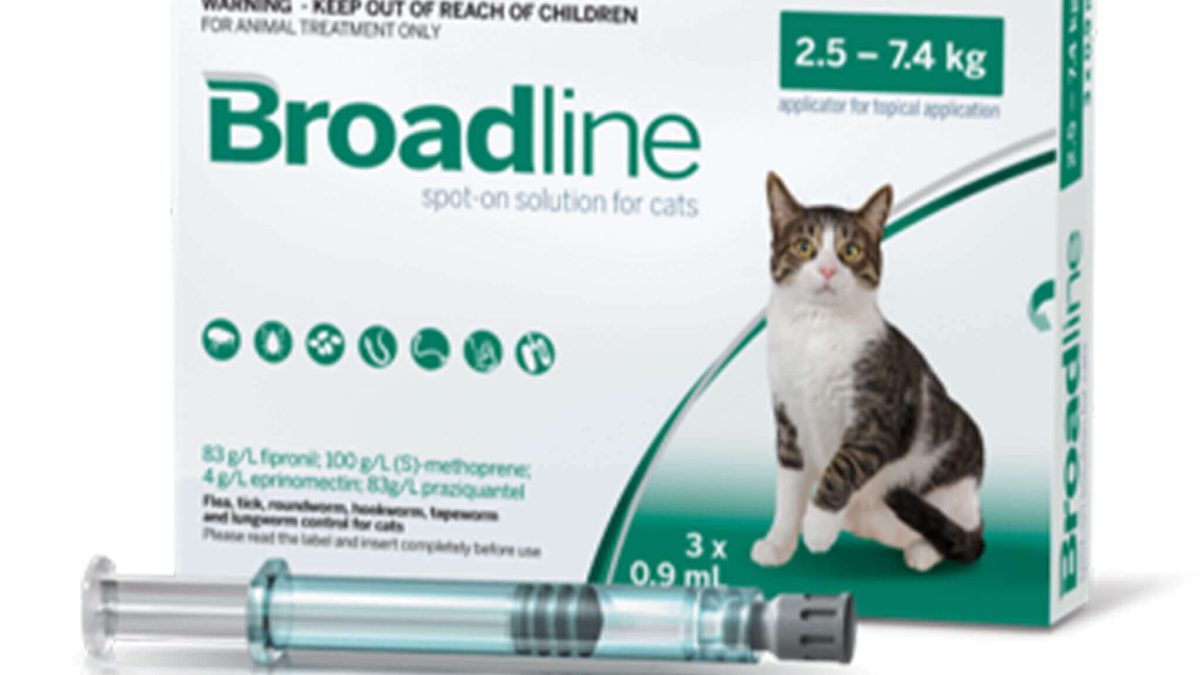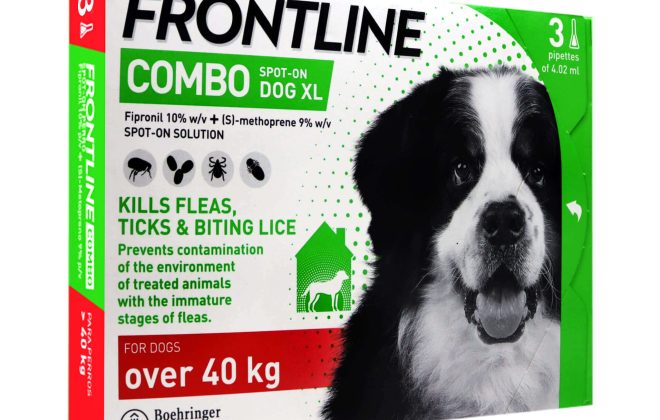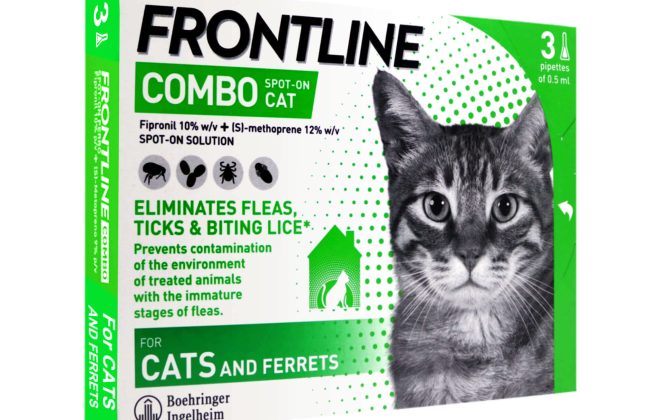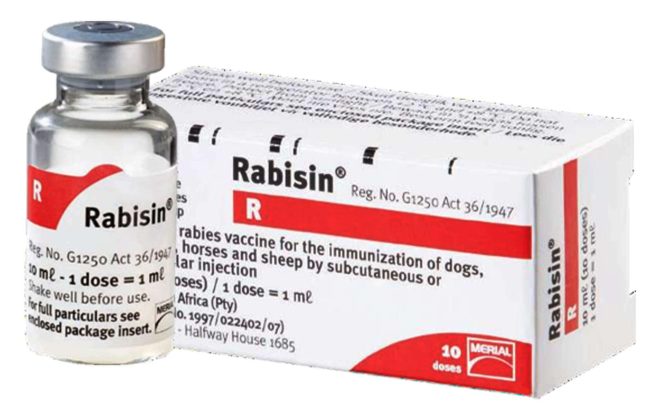
BROADLINE spot-on solution for cats 2.5-7.5 kg | 0.9ml
Description:
BROADLINE is a broad spectrum parasiticide for topical use on cats. It contains fipronil with insecticidal activity against adult fleas and lice, and acaricidal activity against immature and adult ticks; (s)-methoprene with ovicidal and larvicidal activity against immature fleas plus the endectocides eprinomectin and praziquantel to complete the broad spectrum with activity against gastrointestinal nematodes, lungworms and tapeworms and vesical worms. Treatment of notoedric mange (Notoedres cati).
Composition :
• Fipronil 74.7 mg
• (S)-methoprene 90.0 mg
• Eprinomectin 3.60 mg
• Praziquantel 74.7 mg
Species :
Cats 2.5–7.5 kg
Indications :
For cats with, or at risk from mixed infestations by cestodes, nematodes and ectoparasites. The veterinary medicinal product is exclusively indicated when all three groups are targeted at the same time. Ectoparasites • Treatment and prevention of infestations by fleas (Ctenocephalides felis). Elimination of fleas within 24 hours. One treatment prevents further infestations for at least one month. • Prevention of environmental flea contamination by inhibiting the development of flea immature stages (eggs, larvae and pupae) for over a month. • The product can be used as part of a treatment strategy for the control of flea allergy dermatitis (FAD). • Treatment and prevention of infestations by ticks (Ixodes ricinus). Elimination of ticks within 48 hours. One treatment prevents further infestations for up to 3 weeks. • Treatment of notoedric mange (Notoedres cati). Cestodes • Treatment of infestations with tapeworms (Dipylidium caninum, Taenia taeniaeformis, Echinococcus multilocularis , Joyeuxiella pasqualei (adult), and Joyeuxiella fuhrmanni (adult)). Nematodes • Treatment of infestations with gastrointestinal nematodes (L3, L4 larvae and adults of Toxocara cati, adults of Toxascaris leonina, L4 larvae and adults of Ancylostoma tubaeforme and Ancylostoma ceylanicum, and adults of Ancylostoma brazilienze). • Treatment of infestations with feline lungworms (L3 larvae, L4 larvae and adults of Aelurostrongylus abstrusus , L4 larvae and adults of Troglostrongylus brevior). • Treatment of infestations with vesical worms (Capillaria plica). • Prevention of heartworm disease (Dirofilaria immitis larvae) for one month.
Contraindications :
• Do not use on sick or convalescent animals.
Warning:
• Keep out of reach of children, uninformed persons and animals.
• Mild and transient skin reactions at the application site (itching, hairloss) may occur on rare occasions. These signs disappear without further treatment.
• If the cat licks the application site after treatment, temporary excessive salivation can be observed.
• Oral ingestion of BROADLINE may also result in transient neurological signs. Signs resolve without treatment within 24 hours. Correct application will minimise theoccurrence of such events.
• A temporary clumping or spiking of the hair may be seen at the application site after treatment.
• Pregnancy and lactation: The safety of the veterinary medicinal product has not been established during pregnancy and lactation. Laboratory studies with the individual ingredients in rats and rabbits have not produced teratogenic, foetotoxic or maternotoxic effects. Use only according to the risk-benefit assessment by the attending veterinarian.
• Interaction with other medicinal products: No interactions between BROADLINE and routinely used veterinary medicinal products, or medical or surgical procedures have been observed.
• During treatment with BROADLINE, concurrent administration of other antiparasitic macrocyclic lactone should be based upon the risk/benefit assessment of the attending veterinarian, since the potential of interactions in such cases has not been investigated. • Avoid contact with the cat’s eyes.
• After treatment with BROADLINE, ticks will generally be killed within 48 hours after infestation without having a blood meal. However the attachment of single ticks cannot be excluded and transmission of infectious diseases cannot thus be completely excluded.
• No data on the effect of bathing/shampooing on the efficacy of BROADLINE on cats is available.
• However, brief contact of the animal with water on one or two occasions within the month following application is unlikely to significantly reduce the efficacy of BROADLINE.
• Although this remedy has been extensively tested under a large variety of conditions, failure thereof may ensure as a result of a wide range of reasons. If this is suspected, seek veterinary advice and notify the registration holder.
precautions:
Special precautions for use in animals:
• In the absence of available data, do not repeat the treatment at intervals of less than 2 weeks; the treatment of kittens < 7 weeks and/or below 0.6 kg should be based on a risk-benefit assessment. Special precautions to be taken by the person administering the veterinary medicinal product to animals:
• Do not drink, eat or smoke while handling BROADLINE.
• Wash hands after use.
• Used applicators should be disposed of immediately. Stored applicators must be kept in the intact blister package.
• In case of accidental spillage onto skin, wash off immediately with soap and water. In case of accidental eye exposure, flush the eyes carefully with water. Animals or persons with a known hypersensitivity to any of the active ingredients or excipients should avoid contact with BROADLINE.
• If side effects are noted, seek immediate medical assistance and show the package leaflet or label to the physician.
• Avoid direct contact with the application site soon after administration. Children should not be allowed to play with treated cats until the application site is dry. It is recommended that recently treated animals are not allowed to sleep with owners, especially children.
Adverse reactions :
• A temporary clumping or spiking of the hair and mild and transient skin reactions at the application site (itching, hair loss) have been commonly observed at the application site after treatment in clinical studies.
• Temporary excessive salivation was commonly observed following licking the application site after treatment in clinical trials.
• Digestive tract and/or neurological disorders may result following an accidental oral ingestion of the veterinary medicinal product (see section 4.5). Transitory blindness or impaired vision have been observed in very rare cases based on post marketing safety experience.
• Symptomatic treatment can be required if the signs do not resolve spontaneously within 24 hours. Correct application will minimise the occurrence of such events.
Use during pregnancy, lactation:
• The safety of the veterinary medicinal product has not been established during pregnancy and lactation.
Dosage and route of administration :
- Method of administration: Open one blister, remove the applicator from the package and hold it upright. Pull back the plunger slightly, twist and pull off the cap. Part the hair on the midline of the neck, between the base of the skull and the shoulder blades until the skin is visible. Place the tip of the applicator on the skin and apply the entire content directly onto the skin in one spot.
Overdose :
• Safety has been demonstrated with up to 5 times the maximum exposure dose (i.e. up to 15 times the recommended dose) in healthy kittens aged 7 weeks and older treated up to 6 times at four-week intervals. It has also been confirmed in healthy adult cats treated 3 times at two-week intervals with up to 5 times the recommended doses. Mild and transient neurological signs such as ataxia, disorientation, apathy and pupil dilation may be observed, with spontaneous recovery the day after. Transient salivation and/or vomiting could also be observed, both in kittens and adult cats, in isolated cases.
storage:
• Store below 30 oC and away from sunlight.
• Store in the original package.
Package :
Cardboard box containing 3 unit dose applicator(s) of 0.9 ml each.
Related Posts
Leave a Reply Cancel reply
Categories
- Wayzon conferences & Round Table (13)
- Medical convoys (10)
- academy (6)
- Online webinar (18)
- Wayzon events (10)
- veterinary Tips (1)
- services (8)
- Pharmaceuticals (1)
- products (17)
- Antibiotics (6)
- anti inflammatory (2)
- parasiticide (3)
- tonic and supplements (3)
- miscellaneous (7)
- semen (3)
- equipment (8)
- semen A (6)
- about (3)



